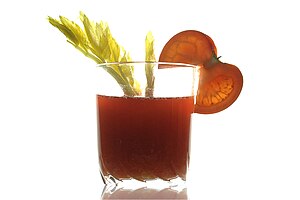 Image via WikipediaTo be blunt, Americans do not eat enough fruits and vegetables. For example, although the National Cancer Institute recommends 5 servings of vegetables and 3 of fruits each day, the truth is this: The average American eats only 1 1/2 serving of vegetables and, on average, no fruit on any given day.
Image via WikipediaTo be blunt, Americans do not eat enough fruits and vegetables. For example, although the National Cancer Institute recommends 5 servings of vegetables and 3 of fruits each day, the truth is this: The average American eats only 1 1/2 serving of vegetables and, on average, no fruit on any given day.Benefits of Juicing
No matter what our age, it is never too late to start drinking your fruits and vegetables. Juices can flush toxins from your body, are good for your weight, heart, circulation, and overall well being. Juices contain saturated fats or added sodium and can be helpful in lowering your cholesterol.
-Juicing breaks cell walls of whole foods including tomatoes and carrots. This way you make it easy for your body to absorb all the wonderful nutrients of the vegetables and fruits.
-Juice is absorbed within 20 minutes. You don't have to waste energy do digest the foods. Nothing energizes you quicker than juice.
-Best way to consume high volumes of greens. Some people wonder, how they can ever eat all the greens that are recommended. Juicing is the solution.
-Greens are the most alkalizing, mineralizing and healthiest foods. But not always the most palatable. By juicing vegetables you can mix with apples or carrots for better taste.
-Juicing only takes a few minutes. More than blending but still quick and much faster and easier than cooking.
-No pans to scrub. Juicers are relatively quick and easy to clean - especially the centrifuge juicers.
-Juicing is easy to learn and you an make and adapt recipes easily.
How to Juice
- Wash the vegetables and fruits.
- Depending on the kind of raw food or juicer, you might have to pre-cut.
- Juice the soft fruits and veggies first. Then the harder and tougher ones (like carrots). the latter will push the softer ones through.
- The best way to begin a regular juicing routine is to do it the same time each day and only begin with the vegetables and fruits that ou enjoy eating whole.
- Fresh fruit and vegetable juices should be consumed right away because if you store them they can lose their nutrition value very quickly.
- It is best to clean juicer right after use.
- The first thing to consider is whether or not to make your own juice. Preparing your own juice will save you money and it will be the freshest it can get. You can buy bottled juices but some of the nutrition is lost in bottling.
- Choose a juicer that does not create excess heat that will destroy valuable nutrients in fruits and vegetables. For juicing green vegetables and grasses - use a twin gear juicer. For juicing harder vegetables such as carrots or soft veggies such as cucumber, it's easier and quicker to use a centrifuge juicer.
- Whenever possible, organic produce should be used for juicing to avoid consuming concentrated amounts of pesticides with your healthy juices.
- If you are juicing primarily for health, use 50-75% greens like spinach, kale, chard, parsley or broccoli as the base of your juice recipe. Fruit juices tend to be higher in sugar and lower in nutrients than vegetable juices. In general, you can get about 8 ounces of juice from a pound of raw produce.
- If yo want juice with no pulp at all, you can use cheesecloth or a coffee filter to further strain juice after it goes through your juicer. As a final juicing tip, consider that the softer the fruit or vegetable, the thicker the juice will be. In fact, the juice extracted from very soft fruits like pears, peaches, strawberries, and apricots is known as nectar.






